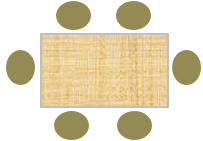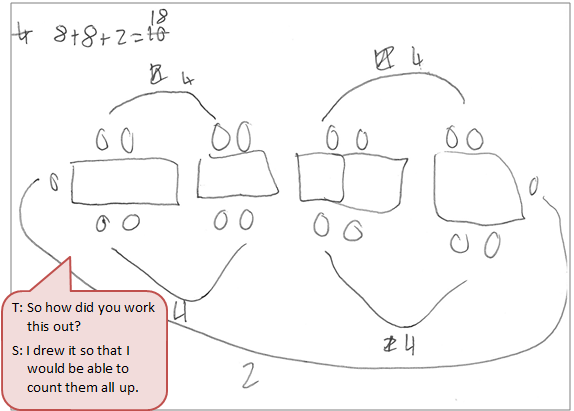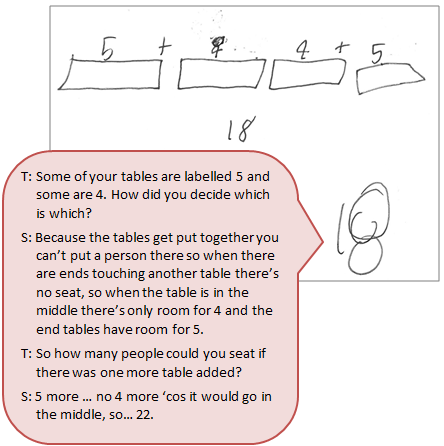The purpose of this activity is to engage students in identifying a (simple linear) pattern and using this to solve a problem.
This activity assumes the students have experience in the following areas:
- Knowing basic addition and subtraction facts.
- Partitioning and regrouping numbers to make calculation easier.
- Using diagrams, materials, and symbols to represent problems.
- Copying, extending, and creating sequential patterns.
The problem is sufficiently open ended to allow the students freedom of choice in their approach. It may be scaffolded with guidance that leads to a solution, and/or the students might be given the opportunity to solve the problem independently.
The example responses at the end of the resource give an indication of the kind of response to expect from students who approach the problem in particular ways.
A restaurant makes a super-long table by placing 4 normal tables end to end for a big party.
Each normal table usually seats 6 people around it.
How many people can sit down to eat at the long table?
The following prompts illustrate how this activity can be structured around the phases of the Mathematics Investigation Cycle.
Make sense
Introduce the problem. Allow students time to read it and discuss in pairs or small groups.
- Do I understand the situation? (Students need to recognise that the tables are joined. The circles represent seats for people.)
- What do the numbers 4 and 6 mean in this problem?
- Do I expect there to be a pattern? Why?
- What will my solution look like? (The solution will be the number of people seated at 4 tables, supported by evidence that the right number is found.)
Plan approach
Discuss ideas about how to solve the problem. Emphasise that, in the planning phase, you want students to say how they would solve the problem, not to actually solve it.
- What strategies will be useful to solve a problem like this? (Making a diagram, acting out, creating a table, and looking for a pattern are all useful strategies that can be combined.)
- What tools will be useful? (Shapes and counters can be used to represent tables and seats.)
- What might the number of seats be? Can the number be odd? Why not? Why must it be even?
- What maths will come in handy for solving this problem?
Take action
Allow students time to work through their strategy and find a solution to the problem.
- Have I shown my workings in an organised way so someone else can see what I did?
- Was there a pattern?
- How did I use the pattern?
- Have I checked my answer? Can I prove it is correct?
- Are my strategies the same as those others used?
Convince yourself and others
Allow students time to check their answers and then either have them pair share with other groups or ask for volunteers to share their solution with the class.
- Which strategies were most efficient?
- Is there a pattern that connects the tables and seats? What is the pattern?
- How can use the pattern to predict the number of seats? How many seats are at 10 tables? 20 tables?... etc.
- Is there some maths that I need to solve problems like this? What is the maths?
Examples of work
Work sample 1
The student draws a picture of the tables and seats. They count the seats to find the solution correctly.
Click on the image to enlarge it. Click again to close.
Work sample 2
The student combines the table diagram with numbers, 5, 4, 4, 5, to indicate the number of seats possible for each table.



